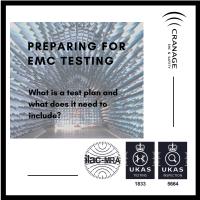 Add My Company
Add My Company

WHAT IS A TEST PLAN AND WHAT DOES IT NEED TO CONTAIN?
A guide to writing an EMC test plan.
If you are new to EMC testing, then we understand that you may not be familiar with the contents of a test plan. A test plan covers the EMC requirements specific to a particular product and allows the test house to assess what is needed to complete testing, including the size of the chamber, number of cables to be tested, power supplies and any specific measurement equipment.
At Cranage, we can assist you with writing a test plan, but the manufacturer will have the best understanding of a product and the environment in which it is intended to be used, and therefore is usually best placed to construct it.
A test plan should be kept along with the Declaration of Conformity (DoC) for each product, which is signed by a manufacturer/importer to show that a product complies with the appropriate standards. Writing an EMC test plan takes time and knowledge, and must be specific to each particular product.
This article gives some details around what is required in an EMC test plan.
• Details on the equipment under test. This will include the make and model of the product, as well as weights and dimensions so that we can ensure we have sufficient capabilities and can accurately calculate the testing time. It should also include information on what the product is to be used for
• Positional requirements. Is this product to be used on a table top or floor standing? This could also include whether it is wall or ceiling mounted.
• Power supply requirements- details around whether it is mains powered, DC, has any internal batteries. The power level and power type will influence what tests need to be performed.
• Operating modes during testing. The plan should also include information on peripheral equipment needed to attain functionality.
• Test parameters. This may include frequency bands, test levels, emissions limits, information on all ports.
• Cable type and length, including the cable manufacturer and model.
• Health and Safety issues must be declared, which may include hazardous materials. Emergency shut down procedures should also be included as susceptibility testing can produce unforeseen malfunctions.
• Standard requirements and country consideration. A manufacturer must verify the requirements for the country in which the item will be sold, and the test plan will be based on the appropriate standard with the country deviations.
• Set up time, including any supporting software
• Details on the intended environment where the product will be used.
Creating a test plan can be difficult, but it is important that EMC compliance is considered in the design of a product in order to minimise risk further down the product life cycle. Get in touch with our team of engineers to discuss your testing requirements and how we can help you
For more information on WHAT IS A TEST PLAN AND WHAT DOES IT NEED TO CONTAIN? talk to Cranage EMC & Safety

